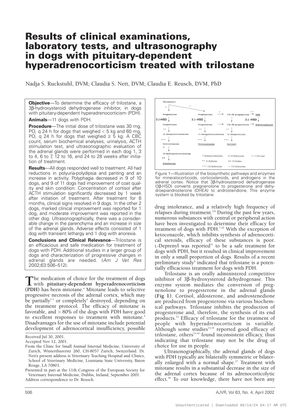Results of Clinical Examinations, Laboratory Tests, and Ultrasonography in Dogs with Pituitary-Dependent Hyperadrenocorticism Treated with Trilostane
April 2002
in “
American journal of veterinary research
”
trilostane 3β-hydroxysteroid dehydrogenase inhibitor pituitary-dependent hyperadrenocorticism PDH ACTH stimulation tests cortisol adrenal glands polyuria-polydipsia panting polyphagia coat quality skin condition trilostane ACTH tests cortisol adrenal glands increased thirst and urination panting increased appetite coat quality skin condition

TLDR Trilostane effectively and safely treats dogs with pituitary-dependent hyperadrenocorticism, improving symptoms and adrenal gland size.
In a study from 2002, 11 dogs with pituitary-dependent hyperadrenocorticism (PDH) were treated with trilostane, a 3β-hydroxysteroid dehydrogenase inhibitor. The initial dose was 30 mg daily for dogs under 5 kg and 60 mg for those 5 kg or over. The dogs underwent a series of tests including blood counts, serum biochemical analyses, urinalysis, ACTH stimulation tests, and ultrasonographic evaluations of the adrenal glands at various intervals up to 28 weeks after treatment began. The results showed that all dogs responded well to the treatment, with reductions in symptoms such as polyuria-polydipsia, panting, and an increase in activity. Additionally, 9 out of 10 dogs showed decreased polyphagia, and 9 out of 11 dogs had improved coat quality and skin condition. Cortisol concentrations significantly decreased one week after treatment initiation. After 6 months, clinical signs resolved in 9 dogs, with the remaining 2 showing marked and moderate improvement, respectively. Ultrasonography revealed considerable changes in the adrenal glands' parenchyma and size. Only two dogs experienced adverse effects: one with transient lethargy and another with anorexia. The study concluded that trilostane is an effective and safe treatment for dogs with PDH, but recommended further studies with more dogs and an analysis of progressive changes in the adrenal glands.

